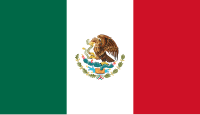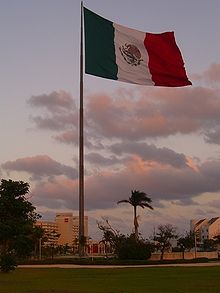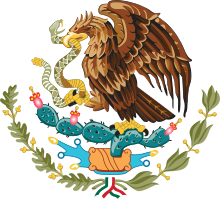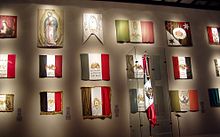Flag of mexico
| Flag of mexico | |
|---|---|
 |
|
| Vexillological symbol : |
|
| Aspect ratio: | 4: 7 |
| Officially accepted: | 16th September 1968 |
The flag of Mexico is a tricolor in green, white, and red, which are the colors of the National Liberation Army of Mexico.
The current flag was introduced in 1968. The appearance is based on the flag that was first hoisted on November 2, 1821. The coat of arms of Mexico was added in the center of the flag two years later. It is a legend about the founding of the Aztec capital Tenochtitlán in 1325 (the same place is now the Mexican capital Mexico City ). The coat of arms has been changed several times throughout history. These modifications were incorporated into the flag.
Appearance and symbolism
The official appearance of the Mexican flag is laid down in Article 3 of the Ley sobre el escudo, la bandera y el himno nacionales ( Law on the State Emblem, Flag and National Anthem ) of 1984. The law regulates what the flag displays and its proportions. Copies of the national flag made under this law are kept in both the National Archives ( Archivo General de la Nación ) and the National Historical Museum ( Museo Nacional de Historia ).
- At. 3: The Bandera Nacional is a rectangle divided into three vertical stripes of identical dimensions, with the colors arranged in the following order away from the mast: green, white and red. Centered in the white stripe is the national coat of arms with a diameter of three quarters of the width of the white stripe. The aspect ratio of the flag is four to seven. A cloth or ribbon can be attached under the flag button
Although the exact colors are not determined by law, the Secretariat of the Interior ( Secretaría de Gobernación ) has made the following recommendations:
| Color scheme | green | White | red |
|---|---|---|---|
| Pantone | 3425c | safe | 186c |
| RGB | 0-104-71 | 255-255-255 | 206-17-38 |
| CMYK | 100-0-32-59 | 0-0-0-0-0 | 0-92-82-19 |
coat of arms
The coat of arms is based on an Aztec legend about the founding of Tenochtitlán . According to this, the Aztecs , who were still nomadic at the time, were looking for a sign that indicated the exact location of their capital to be founded. The god Huitzilopochtli had instructed them to find an eagle sitting on a cactus devouring a snake. This cactus should grow on a rock in the middle of a lake. After two hundred years of wandering, they found the promised sign on a small island in boggy Texcoco Lake . Here they founded their new capital Tenochtitlán, today's Mexico City . The current coat of arms was redesigned in 1968 by Francisco Eppens Helguera and introduced by President Gustavo Díaz Ordaz .
Meaning of the colors
The colors go back to the banner of the Army of the Three Guarantees (Ejército Trigarante or Ejército de las Tres Garantías), which fought in the Mexican War of Independence. Originally the colors had the following meaning:
- Green : Independencia (independence from Spain )
- White : Religión (religion, Roman Catholic Church )
- Red : Unión (Union between Europeans and Americans )
The meaning of the colors changed with the President Benito Juárez -driven secularization of the country. The new meanings are as follows:
- Green: hope
- White: unity
- Red: blood of the heroes
The World Encyclopedia of Flags , a book by Alfred Znamierowski, also gives the following meanings:
- Green: hope
- White: purity
- Red: religion
Since Article 3 of the Flag Act does not define any official symbolism of colors, they are also assigned a number of other meanings. Some states of Mexico, such as B. Querétaro and Hidalgo have either part or even the whole flag of Mexico integrated into their coat of arms.
history
Various flags that were used during the Mexican War of Independence had a major influence on the appearance of the first national flag. Although it was never used as an official flag, many historians consider the standard of the Virgin of Guadalupe to be the first flag of Mexico. This was used by Miguel Hidalgo during the Grito de Dolores on September 16, 1810 . The standard became a symbol of the rebel army during the Mexican War of Independence. Several other flags were also used during the war. José María Morelos, for example, used a flag on which, to the image of the Virgin, a blue and white insignum with a crowned eagle on a cactus and the letters VVM ( Viva la Virgen María - “Long live the Virgin Mary”) was added. The Revolutionary Army also used a flag made up of three vertical stripes of white, blue and red. The current colors - green, white and red - first appeared in the flag of the United Army of the Three Guarantees after independence from Spain was achieved.
The first official national flag was introduced in 1821, the first year of Mexican sovereignty. The first government chose a tricolor consisting of a green, a white and a red stripe with the coat of arms in the middle. The official decree:
"The only article: (...) the national flag and the flags of the army should be three-colored and forever assume the vertically arranged colors green, white and encarnado [flesh-red], with the crowned eagle in the center of the white stripe, according to the following appearance."
Although very similar to the current national flag, the eagle does not hold a snake in its claws on this first one and wears a crown in honor of the empire. Variants of this flag that can be found at this time are the sea flag on which, in addition to the three colored stripes, only the eagle with the crown is shown. The eagle is larger on the square military flag than on the national flag. The national flag was formally introduced by Emperor Don Agustín de Iturbide in November 1821 and was first used in July 1822. With the abolition of the empire, the flag lost its validity.
The second national flag came with the establishment of the first Federal Republic in 1823. The new flag, which was introduced in April, differs in that the eagle's crown was removed and a snake was placed in its right claw. Another innovation was the addition of an oak branch and a laurel branch at the suggestion of Minister of War José Joaquín de Herrera . A tradition that has survived to the present day flag. With the dissolution of the Federal Republic in 1864, this flag also lost its validity.
The third national flag was that of the Second Mexican Empire. Again the green-white-red color scheme was chosen. However, this time the aspect ratio was changed from 4: 7 to 1: 2. In addition, an eagle with a crown was placed in each corner. The appearance, which was ordered by Emperor Maximilian I , was based on the appearance of the French coat of arms, with a "Mexican touch".
The flag was abolished with the fall and subsequent execution of Maximilian by the Mexicans. For this, the second Mexican flag was again introduced, but never officially. The current national flag was introduced on September 16, 1968 and confirmed by law on February 24, 1984.
Various official flags were used by the government prior to the introduction of the current flag. What they all had in common was the structure of the tricolor. Differences existed in the coat of arms that was and is to be seen in the middle. One possible reason for the introduction of the flag and the new coat of arms in 1968 is that Mexico City hosted the Summer Olympics . At the same time, the variant without a coat of arms, previously used as a trade flag, was also abolished. In 1984 a debate arose over how the coat of arms should be depicted on the back of the flag. To solve this problem, a member of the Partido Acción Nacional suggested changing the law so that the eagle on the back could also look to the right. In 1995 the law was changed.
- Development of the Mexican flag (1821–1968)
Flag protocol

When the flag is used in a parade, people wearing military uniforms are required to salute. Citizens salute the national flag as follows: Standing firmly, place your right hand on your chest. The hand is flat and the inside points downwards. This salute is known as El Saludo Civil de la Bandera Nacional . When the president appears as the top leader of the military , he salutes with the military salute. When the Mexican anthem is played on Mexican television at the start and end of the program, the flag is shown at the same time.
On special days, the flag is hoisted by both civilians and government personnel. These are mostly national holidays and days of special importance in Mexico. For some events, such as the death of important personalities and memorial days, hoisting to half-mast is also provided. These dates are listed in Article 18 of the Flag Act.
The Día de la Bandera (Flag Day) takes place on February 24th. On this day, in 1821, the individual armies of the Mexican War of Liberation united to form the Army of the Three Guarantees.
variants
There are two variants of the national flag that are legally secured. The difference lies in the design of the coat of arms depicted in it. In the first variant, which is used by the Mexican president and ministers, the coat of arms is largely gold, except for the three-colored ribbon, in green, white and red. The stone, the lake and the eagle claws are silver-colored. In the second variant, the entire coat of arms is gold-colored, including the ribbon, the lake, the stone and the claws. This second variant is used by the state government and state agencies that are not allowed to use the first variant.
Devices
Article 3 of the Ley sobre el escudo, la bandera y el himno nacionales also describes that the national flag can be decorated with a special ribbon, the "Corbata". The corbata consists of a knot and two ribbons that are of unequal length. The ribbons are connected with a golden tassel called a "fringe". The Corbata is shown above, on the flag head. Organizations and parties can use their own corbatas. The PAN uses a white corbata with a blue fringe.
Banderas monumentales
In 1999, President Ernesto Zedillo began hoisting gigantic flags across the country. Under the direction of the Ministry of Defense, the banderas monumentales (monumental flags) were set up in various cities and locations, namely in Mexico City , Tijuana , Ciudad Juárez and Veracruz . The decree also set the dimensions of the flags from 14.3 to 25 meters, which are hoisted on masts 50 meters high. After the first monumental flags were hoisted, cities like Ensenade , Nuevo Laredo and Cancún allegedly followed suit , setting up their own monumental flags. Smaller flags, called banderas semi-monumentales, were erected in smaller towns and in several training centers.
The largest monumental flag in Mexico is the one in Mirador del Obispado in Monterrey , with a mast weighing 120 tons and 100.6 meters high. The flag measures 50 by 28.6 meters and weighs 230 kilograms; four times the size of most monumental flags. It stands on the top of the Cerro del Obispado (Diocesan Hill), at an altitude of 775 meters above sea level (the city is at 538 meters).
- places
- Monterrey , Nuevo León
- Dolores Hidalgo , Cuna de la Independencia Nacional, Guanajuato
- Querétaro , Querétaro
- Mexico City ( Federal District ):
- Iguala , Guerrero
- Tonalá , Jalisco
- Mérida , Yucatan
- Cancun , Quintana Roo
See also
Web links
- Flags of the World - Mexico (English)
- Presidency of Mexico - National Symbols (Spanish)
- Representations of historical Mexican flags (Spanish)
Individual evidence
- ↑ Flags of the World page "Mexico"
- ↑ Vexilla mundi page "Mexico" ( Memento of the original dated February 11, 2005 in the Internet Archive ) Info: The archive link was inserted automatically and has not yet been checked. Please check the original and archive link according to the instructions and then remove this notice.
- ↑ Inkscape RGB to CMYK converter (approx.)
- ↑ a b Alfred Znamierowski: The World Book of flags. Hermes House, London 2002, p. 200.
- ↑ Benito Juárez 'biography on the website of the former President Ernesto Zedillo ( Memento of the original from June 15, 2006 in the Internet Archive ) Info: The archive link was automatically inserted and not yet checked. Please check the original and archive link according to the instructions and then remove this notice.
- ↑ a b Representations of historical Mexican flags ( Memento of the original from April 27, 2006 in the Internet Archive ) Info: The archive link was inserted automatically and has not yet been checked. Please check the original and archive link according to the instructions and then remove this notice. (span.)
- ↑ Juán López de Escalera: Diccionario Biográfico y de Historia de México. Editorial del Magisterio, México, 1964.
- ↑ January 7, 1822 Decree introducing the imperial flag.
- ↑ Mexican Empire (1821–1823) ( Memento of August 10, 2004 in the Internet Archive )
- ↑ Mexico (1823–1864 / 1823–1880) ( Memento of October 16, 2005 in the Internet Archive )
- ↑ Mexican Empire (1864–1867) ( Memento from December 29, 2004 in the Internet Archive )
- ↑ Vivien Lougheed: Adventure Guides Mexico's Pacific Coast. Hunter Publishing, ISBN 1-58843-395-1 , p. 5.
- ↑ Flags of the World page: Mexico - Flag without arms ( Memento of March 10, 2007 in the Internet Archive ) (English).
- ↑ Flags of the World page Mexico - Reverse side of the flag ( Memento of the original from February 28, 2008 in the Internet Archive ) Info: The archive link was inserted automatically and has not yet been checked. Please check the original and archive link according to the instructions and then remove this notice.
- ↑ Article 41 of the Flag Act ( Memento of the original of November 14, 2004 in the Internet Archive ) Info: The archive link has been inserted automatically and has not yet been checked. Please check the original and archive link according to the instructions and then remove this notice.
- ↑ Flags of the World page Mexico - Coat of arms ( Memento of the original from November 25, 2005 in the Internet Archive ) Info: The archive link was inserted automatically and has not yet been checked. Please check the original and archive link according to the instructions and then remove this notice.
- ^ Photo of the PAN flag with the Corbota
- ↑ Installation of a semi-monumental flag in León, Guanajuato ( Memento of the original from November 26, 2006 in the Internet Archive ) Info: The archive link was inserted automatically and has not yet been checked. Please check the original and archive link according to the instructions and then remove this notice. September 2005 (span.)
- ↑ Secretariat of Interior article ( Memento of the original from March 10, 2007 in the Internet Archive ) Info: The archive link was inserted automatically and has not yet been checked. Please check the original and archive link according to the instructions and then remove this notice. (Spanish)















